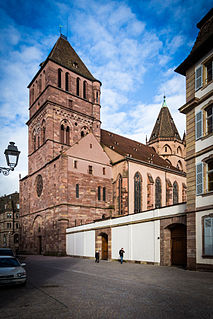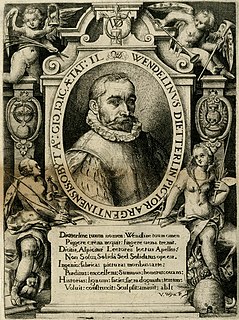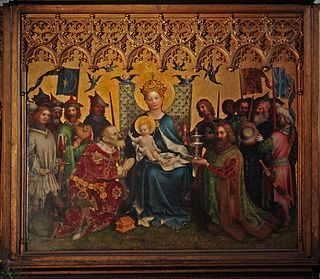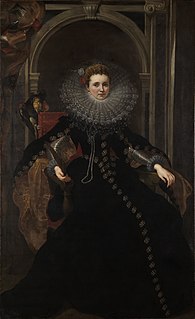
Hans Baldung, called Hans Baldung Grien,, was an artist in painting and printmaking, engraver, draftsman, and stained glass artist, who was considered the most gifted student of Albrecht Dürer, whose art belongs to both German Renaissance and Mannerism. Throughout his lifetime, he developed a distinctive style, full of colour, expression and imagination. His talents were varied, and he produced a great and extensive variety of work including portraits, woodcuts, drawings, tapestries, altarpieces, stained glass, allegories and mythological motifs.

SebastianStoskopff was an Alsatian painter. He is considered one of the most important German still life painters of his time. His works, which were rediscovered after 1930, portray goblets, cups and especially glasses. The reduction to a few objects, which is characteristic of early still life painting, can again be recognized in Stoskopff's painting. His chief works hang in his hometown of Strasbourg, but some of the world's most important art museums own paintings by Stoskopff as well.

Eugen Gustav Dücker was a Baltic German painter, in the Romantic atyle, associated with the Düsseldorfer Malerschule.
The decade of the 1420s in art involved some significant events.

St Thomas' Church is a historical building in Strasbourg, eastern France. It is the main Lutheran church of the city since its cathedral became Catholic again after the annexation of the town by France in 1681. It is nicknamed the "Protestant Cathedral" or the Old Lady, and the only example of a hall church in the Alsace region. The building is located on the Route Romane d'Alsace. It is classified as a Monument historique by the French Ministry of Culture since 1862. Its congregation forms part of the Protestant Church of Augsburg Confession of Alsace and Lorraine.

The Master of the Saint Bartholomew Altarpiece was an Early Netherlandish painter active in Germany, mostly Cologne, between 1475/1480 and 1510. Despite his anonymity, he is one of the most recognizable artists of the early Renaissance period in German art.

Johann, Johannes or Hans Wechtlin was a German Renaissance artist, active between at least 1502 and 1526, whose woodcuts are his only certainly surviving work. He was the most prolific producer of German chiaroscuro woodcuts, printed in two or more colours, during their period in fashion, though most of his output was of book illustrations.

The Musée de l'Œuvre Notre-Dame is the city of Strasbourg's museum for Upper Rhenish fine arts and decorative arts, dating from the early Middle Ages until 1681. The museum is famous for its collection of original sculptures, glass windows, architectural fragments, as well as the building plans of Strasbourg Cathedral. It has a considerable collection of works by Peter Hemmel von Andlau, Niclas Gerhaert van Leyden, Nikolaus Hagenauer, Ivo Strigel, Konrad Witz, Hans Baldung and Sebastian Stoskopff.

Hinrik Bornemann was a Northern German Late Gothic painter. He was the son of Hans Bornemann, who died in 1474. After his father's death his mother was thrice remarried to painters- to Hinrik Funhof, to Absolon Stumme, and then finally to Wilm Dedeke. His main work was the Altarpiece of St. Luke (Lukas-Altar) for St. Mary's Cathedral in Hamburg, now shown in St. James the Greater Church. Upon his death in 1499 it was left unfinished, and was completed by Wilm Dedeke.

Wendel Dietterlin (c.1550–1599), sometimes Wendel Dietterlin the Elder, to distinguish him from his son, was a German mannerist painter, printmaker and architectural theoretician. Most of his paintings are now lost, and he is best known for his treatise on architectural ornament, Architectura, published in its final edition in Nuremberg in 1598.

The term Cologne School of Painting was first applied in the 19th century to describe old German paintings generally. It subsequently came to refer more specifically to painters who had their workshops in medieval Cologne and the lower-Rhine region from about 1300 to 1550.

Kurt Martin was a German art historian.
The Master of the Drapery Studies, also known as Master of the Coburg Roundels is the notname given to the "very productive" and "multifaceted" late 15th-century author of some 30 surviving paintings and over 150 surviving drawings. Indeed, according to the J. Paul Getty Museum, up to 180 surviving drawings "have been attributed to this master, comprising one of the most extensive bodies of drawn work of any northern European artist before Albrecht Dürer." Conversely, it has been suggested at least once that both the Master of the Drapery Studies and the Master of the Coburg Roundels may be two separate persons and that their body of work is attributable to a whole circle of artists.
CasparIsenmann was a Gothic painter from Alsace. As the municipal painter of his hometown Colmar and the creator of a major altarpiece for the prestigious St Martin's Church, he was an important representative of the Upper Rhenish school of painting of the mid-15th century and a probable master of Martin Schongauer.

The Master of the Karlsruhe Passion is the notname of a German painter of the late Gothic period active in the Upper Rhine. Very influential on other painters in the region, he may be identified with the Strasbourg painter Hans Hirtz. He is named after his main work, the Karlsruhe Passion, though he may also have been the artist behind the murals in the former Dominican church in Strasbourg, only known through two 17th century copies.

Peter Hemmel of Andlau was a late Gothic stained glass artist, whose workshop in Strasbourg was active between 1447 and 1501. Sometimes working alone and sometimes in collaboration with other stained-glass artists in the city, it mainly supplied religious buildings in what is now Austria, southern and eastern Germany, eastern France and northern Italy, though none of Hemmel's windows survive in Andlau itself.

Jost Haller was a 15th-century Gothic painter from Alsace, active in the years 1440–1470, first established in Strasbourg, then in Metz, and in Saarbrücken. He is also called The painter of the knights [not "The painter of knights", or Le peintre de chevaliers].
The Master of the Tennenbach Altar, sometimes referred to as the Master of the Staufen Altar, was a Gothic painter active in the Upper Rhine in the second quarter of the 15th century whose real name is unknown. His working name is taken from the altar paintings he created, formerly in Tennenbach Abbey, a Cistercian monastery in the Black Forest in Baden-Württemberg, Germany. The work is also sometimes mistakenly known as the Staufen Altar from its supposed later location in Staufen im Breisgau.

Anna Maria von Baden-Durlach was a German poet and painter. She was a daughter of Margrave Georg Friedrich von Baden.

Mariä Krönung is a Catholic pilgrimage church in Lautenbach, Baden-Württemberg, Germany, where pilgrimage to a miraculous image of Mary was documented in the 14th century. The present church was built in the 15th century in Late-Gothic style, a home for Premonstratensian friars from a dissolved monastery. Mariä Krönung is a significant cultural monument in southern Germany, because it retains many original Gothic features, such as the rood loft and fused stained-glass windows. It has been the parish church of the village since 1815.

















